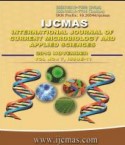


 National Academy of Agricultural Sciences (NAAS)
National Academy of Agricultural Sciences (NAAS)

|
PRINT ISSN : 2319-7692
Online ISSN : 2319-7706 Issues : 12 per year Publisher : Excellent Publishers Email : editorijcmas@gmail.com / submit@ijcmas.com Editor-in-chief: Dr.M.Prakash Index Copernicus ICV 2018: 95.39 NAAS RATING 2020: 5.38 |
Pseudo cereals namely Buckwheat (Fagopyrum esculentum Moench.) is gluten-free grains characterized by an excellent nutrient profile. They have been used as nutritious ingredients in gluten-free formulations. They have been considered as underutilized food material in India and used mainly used in fasting days. In buckwheat kernel, outer hull or husk, which is comprises about 30% of the weight of the buckwheat grain. Since, it is inedible and not digested by human beings so it should be removed from buckwheat before processing. The performance evaluation of buckwheat dehuller was found to be influenced by the moisture content of the kernel (6 to 9% wb.), roller speed (500 to 1000 rpm) and feed rate (25 k to 75 kg/h). The overall performance was expressed in terms of dehulling efficiency and percent of broken kernel. Dehulling efficiency and percent of broken kernel increased with increase in roller speed up to 800 rpm, increase in feed rate up to 40 kg/h and then decreased further with increase in roller speed and feed rate and decrease in the kernel moisture content. The results of an optimization technique revealed that the best dehulling performance could be obtained if the system is operated at roller speed of 800 rpm and feed rate of 40 kg/h with moisture content of 6% wb. Under these conditions, the values of dehulling efficiency and percent of broken kernel were 66.61% and 6.19, respectively. Second order polynomial equations relating dehulling efficiency and percent of broken kernel to moisture content, impeller speed and feed rates for the buckwheat grains are developed. With this also dehulling operation was performed in double pass for this grains at optimized parameters in the machine to analyze the dehulling efficiency and percent of broken kernel in double pass and it was found, the dehulling efficiency and percent of broken kernel were 74.52% and 10.28% respectively.
 |
 |
 |
 |
 |